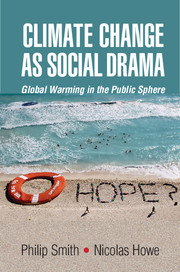Book contents
- Frontmatter
- Contents
- Acknowledgments
- 1 Introduction: The Problem of Climate Change
- 2 Climate Change as Social Drama
- 3 Narrating Global Warming
- 4 An Inconvenient Truth: The Power of Ethos
- 5 Climate Change Art: An Illustrative Failure?
- 6 Climategate and Other Controversies
- 7 The Climate Conference as Theatre
- 8 Local Dramas: The Places of Climate Change
- 9 Conclusion: The Show Must Go On
- References
- Index
4 - An Inconvenient Truth: The Power of Ethos
Published online by Cambridge University Press: 05 May 2015
- Frontmatter
- Contents
- Acknowledgments
- 1 Introduction: The Problem of Climate Change
- 2 Climate Change as Social Drama
- 3 Narrating Global Warming
- 4 An Inconvenient Truth: The Power of Ethos
- 5 Climate Change Art: An Illustrative Failure?
- 6 Climategate and Other Controversies
- 7 The Climate Conference as Theatre
- 8 Local Dramas: The Places of Climate Change
- 9 Conclusion: The Show Must Go On
- References
- Index
Summary
In 2006, a London-based liberal think tank, the Institute for Public Policy Research, issued a paper arguing that the case for climate change needed to be made more effectively (Ereaut and Segnit 2006). Written by two public relations and marketing specialists, Warm Words suggested that the battle for public attention was being lost thanks to mixed messages, contradictory scraps of information, and contending expert opinions in the mass media. Climate change discourse in the United Kingdom was “confusing, contradictory and chaotic” (7). Every argument was met with a counterargument, apocalyptic scenarios were confronted by cheery visions of an emergent British wine industry, and the overall story the public got was that “nobody really knows.” It suggested a new strategy was needed by climate change advocacy groups. This would treat “climate-friendly activity as a brand that can be sold” (28). There would be less reference to a top-down “message” from experts and authority sources with the implication of “rational argument.” Rather, it urged that “we need to work in a more shrewd and contemporary way, using subtle techniques of engagement” (28). These would include getting the issue onto the “emotional radar” and constructing a myth of “ordinary heroism” in which everyday folk could take on a huge task (8).
It was perhaps imprudent to publish a document, which amounted to an own-goal by activists (we review other clangers in Chapter 6). Critics pounced on it as evidence that the climate change camp is characterized by patronizing and sneaky spin doctors who wish to replace an ongoing rational debate with insidious and patronizing propaganda. The pain of the self-inflicted wound was redoubled by the fact that there was no need to publish. Although far more respectful of science and of the need for debate than Warm Words, by the time of the cultural strategy document's appearance, Al Gore's efforts to get climate change taken seriously had already made use of myth, emotion, and those “subtle techniques of engagement.”
It is generally agreed that the 2006 film An Inconvenient Truth featuring Al Gore and directed by Davis Guggenheim (2006) was a pivotal moment in the history of global warming discourse.
- Type
- Chapter
- Information
- Climate Change as Social DramaGlobal Warming in the Public Sphere, pp. 71 - 87Publisher: Cambridge University PressPrint publication year: 2015

